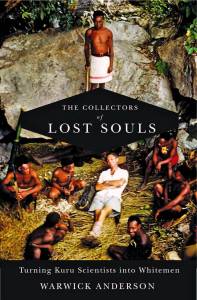Guest post by Warwick Anderson
We invited Warwick Anderson, author of The Collectors of Lost Souls: Turning Kuru Scientists into Whitemen, to comment on a study published last week in the journal Nature, covered in the Washington Post and elsewhere, about genetic resistance to the molecule that causes kuru and several other fatal brain diseases.
 The story of kuru keeps on giving. Just when we think there’s nothing more to learn, we find that another chapter, or at least a footnote, is being written.
The story of kuru keeps on giving. Just when we think there’s nothing more to learn, we find that another chapter, or at least a footnote, is being written.
The recent discovery in London, by John Collinge and his team, of a variant of the protein that forms prions, which offers protection against such pathological forms, is intriguing. In The Collectors of Lost Souls I described the conflicted and perilous history of research into the fatal brain disease kuru, which afflicted the Fore people of highland New Guinea in the 1950s, threatening to wipe them out. American virologist D. Carleton Gajdusek showed through inoculations of chimpanzees that the disease was transmissible, though often it took years for it to become manifest. (For the discovery of the first human “slow virus”—a new cause of human disease—he was awarded the 1976 Nobel Prize in physiology or medicine.) Anthropologists determined that cannibalism had spread the disease, up to when it was suppressed around 1960. Later, Stanley Prusiner argued forcefully that the slow virus was really a malformed pathogenic protein, a normal substance in the body that causes disease when misshapen. He called these disfigured proteins “prions,” for which he was awarded the 1997 Nobel Prize. Gajdusek pushed back against this, claiming that if one could call a computer virus a virus then one could call a prion a virus, too. The Nature article and Collinge’s research more generally indicates that Prusiner won this battle: prion science has become normal science, entirely conventional, even if rather peculiar in its modality.
As I describe in my book, Collinge and his team in London took up prion research partly in response to the “mad cow,” or bovine spongiform encephalopathy, epidemic in Britain in the 1980s and 1990s. They have helped to unravel the genetic basis of susceptibility and resistance to prion disease, studies that have culminated in this article. In this way, they have linked a disease of New Guinea human cannibalism with the bovine cannibalism derived from UK industrial agriculture and animal husbandry.
Aside from prion hegemony, another intriguing aspect of this research is the shift from the field studies that once unraveled the kuru mystery— and indeed, the BSE epidemic—to laboratory investigations of transgenic mice. Increasingly, genetic and molecular manipulations of one sort or another are replacing old-fashioned field investigations in the prion research, as in other realms of biomedical research. In this brave new world, there is little place for anthropological and sociological observation and insight. Ironically, what caused kuru to stop was government suppression of cannibalism—a social intervention—but now in the Nature article, the emphasis is on the possibility of genetic or molecular means of prevention of prion diseases. Here we find another example of molecular medicine substituting for social medicine. It’s the default position of contemporary biomedical science.
Finally, the return to evolutionary explanations is historically significant. In a sense, the laboratory experiments are revealing some of what must have happened among the Fore in the twentieth century: their biological history. There was clearly some selective advantage in having the variant protective form of the protein. From the 1950s, F. Macfarlane Burnet, Gajdusek’s mentor and inspiration at the time, regarded New Guinea as a vast laboratory for the study of disease ecology, the co-evolution of “parasite” virulence and host resistance.The study by Collinge and his team reveals how this evolutionary process must have happened under the selection pressure of the kuru epidemic, just as Burnet predicted. These results would have delighted Burnet, confirming his faith in ecological understandings of disease patterns.
For more than twenty years Warwick Anderson, medical doctor and historian of science, has been studying kuru, those who were infected by the disease, and the scientists who identified and investigated it. He is the author of The Collectors of Lost Souls: Turning Kuru Scientists into Whitemen, Colonial Pathologies: American Tropical Medicine, Race, and Hygiene in the Philippines and The Cultivation of Whiteness: Science, Health, and Racial Destiny in Australia and the coauthor of Intolerant Bodies: A Short History of Autoimmunity.


